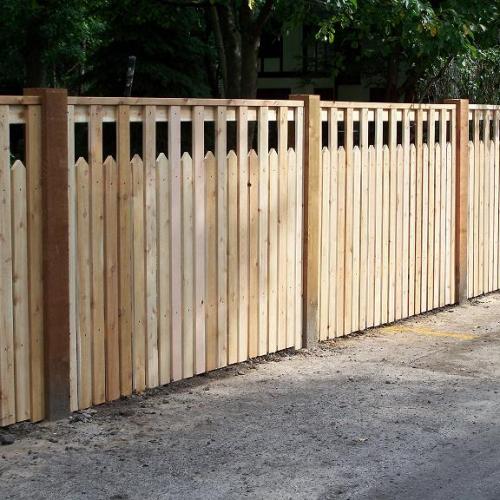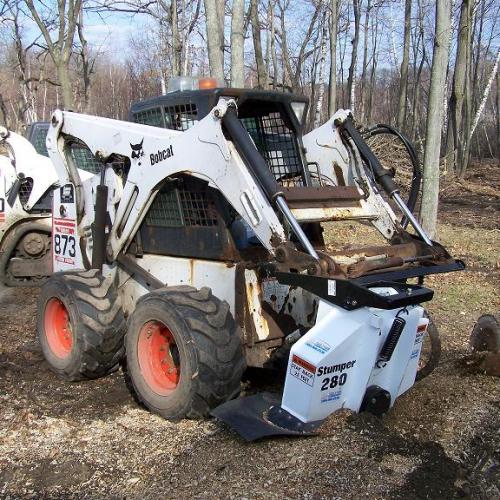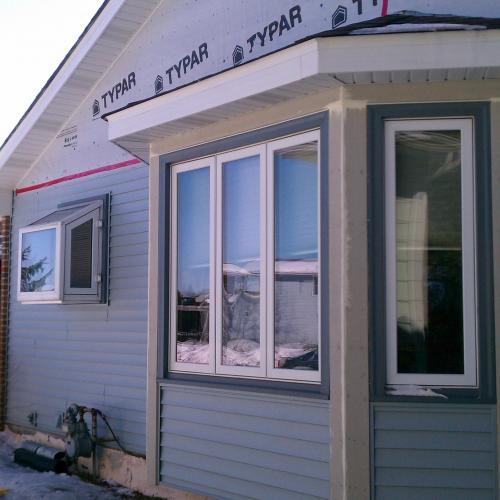NORTHLAND LANDSCAPE & CONSTRUCTION FAQS
Frequently asked questions people have about their landscaping and construction projects
Additions & Porches
? What kind of additions can you build onto a house or garage to help expand square footage?
There are many different options out there to help expand a living area. These options would include, but are not limited to: extending your kitchen, finishing your basement, creating a sunroom, enclosing a front porch, constructing a mudroom, adding onto a bathroom, making your garage larger by adding a room on top of it, building a second story to your house, or creating a bump-out.
? What’s cheaper: to add on to a building, or build the building up?
If you’re looking at adding onto a building, and are wondering if it would be cheaper to just add on to the existing building, or to build it up, it may actually be cheaper to build a second story than it would be to extend it from the ground floor. This is because a ground floor requires more time and resources into the excavating, ground leveling and new foundation of the addition.
? Is it worth adding a porch to a house?
Yes, adding a porch onto a house will add value to your home if it effectively increases or extends the living space. And depending on the area and what kind of porch is installed, a homeowner can expect a 75% return on their investment of home value on average.
Concrete
? What is the difference between concrete and cement?
Cement is actually the ingredient that is used in combination with water and an aggregate (typically sand, gravel or crushed stone) to make concrete.
? How long does it take for concrete to dry?
It takes typically 24 to 48 hours for concrete to dry enough for you to be able to walk on it. After 7 days you should be able to drive on it. By 28 days, concrete should be fully cured and have reached it’s full strength.
? Should you seal concrete?
Since concrete is porous, it tends to take in moisture. In order to prolong the life of concrete, you should seal it to prevent mold and mildew. Left unsealed in a cold climate, it could also cause crumbling, chipping and cracking.
Decks
? Does a deck add value to a home?
Decks do add value to a home, and depending on the kind of deck you install, you can see anywhere between 60-75% return of investment on your project.
? What is cheaper, a deck or patio?
Typically patios are more cost-effective because the materials used for a patio tend to be less expensive. However, your return on investment for a deck tend to be about 15-20% more than what you would get out of a patio.
? What type of materials are used for a deck?
Deck materials come in many different options and it really all depends on how much you want to spend and how much maintenance you want to put into it. The materials decks have to offer are pressure-treated woods such a brown-treat or green-treat, wood decking like cedar, composite decking, or hardwood decking like Ipe, Tigerwood or Teak.
Fences
? What kind of fence is best for property value?
The wooden picket fence tends to be the best for property value, followed by a wrought iron-style fence, then vinyl.
? Which fencing material is the best option for Minnesota?
The best fencing material to be used for this cold state would be wood, chain link, wrought iron, aluminum or vinyl.
? Do I need a permit to have a fence installed?
Depending on the county and the dimensions of the fence, we may need to obtain a permit in order to install your fence. A locator may also be needed to come out to mark the correct property lines.
Foundations & Framing
? What are the most common types of foundations for a house?
The most common types of foundations found for a house are basements, crawlspace and concrete slabs. For Minnesota, the most common type of foundation is the concrete slab foundation.
? How long do house foundations typically last for?
On average, a house foundation can last around 80-100 years before needing to be replaced if properly cared for.
? What is the most common type of framing used in residential construction?
The most typical kind of framing used for residential construction is the “platform” framing, in which each story is framed on top of the previous one.
General Landscaping
? What is landscaping?
Landscaping is a term that entails planning and designing an outdoor area to improve gardens and a building’s surroundings to make them attractive, while also creating usable space.
? What is the difference between landscaping and landscape design?
Landscape design is the ability to put together a detailed layout of an area for an outdoor space to organize and enrich it with plants and structures for both aesthetic or practical purposes. Landscaping is the action of constructing the design that was put together so you can make your outdoor space and surroundings functional and attractive.
? Why should you landscape your yard?
You should landscape your yard because not only will it help with curb appeal to your property and functionality of your land, but it will also help with preserving and conserving your natural surroundings, reduce stress, stop the erosion of soil, and bring wildlife into your back yard such as birds and butterflies.
Heavy Equipment Services
? What is considered “heavy equipment”?
Heavy equipment is machinery that is designed to complete heavy-duty tasks involving earthwork or larger construction tasks in fields such as forestry, mining, construction and industrial sites.
? What kind of equipment is considered “heavy equipment”?
Heavy equipment consists of skid steers, backhoes, cranes, trenchers, bulldozers, road grader, excavator, forklifts, dump trucks, compactors, boom lifts, track loaders, scissor lifts, UTV’s, and off-highway trucks.
? What kind of work can heavy equipment do?
With the right type of equipment, heavy equipment can help with: driveways, parking lots, foundations, public and private roads, landscaping, construction, grading, trenching, excavating, digging, farming, painting, tree removal, roofing, land clearing, demolition, home renovations, drainage ditches, snow removal, hauling in and spreading materials, material handling and stump grinding.
Paver Patios
? Is a paver patio a good investment?
If you plan on installing a paver patio, depending on the project, expect your return of investment to be around 20% to 30% when it comes time to sell or refinance your property.
? How long do paver patios last?
Depending on what material you choose, and with proper care, maintenance and without any major repairs, a paver patio can last for a minimum of 20-25 years. If properly cared for and sealed, they can last 50 to 100 years, or even longer!
? Which is cheaper, concrete or pavers?
Installing concrete is technically the more affordable route per square foot between installation and material costs. However, pavers offer greater durability and value in the long run, even if they do cost a little more upfront.
Pole Barns & Garages
? What’s the difference between a pole barn and a garage?
Pole barns are considered a large structure that isn’t constructed on a traditional foundation. They are built with a series of poles placed in specific locations in the ground to create an informal foundation. They have high ceilings, wide-open spaces with no basements. They are typically cheaper to build than a garage because you don’t need to lay a concrete foundation.
? What are the advantages of a pole barn?
There are several reasons why a pole barn has it’s advantages. Pole buildings tend to be sturdier than a stick frame building because of the thick columns used to create a rigid foundation, which helps transfer both weight and mass effectively. Pole buildings can be built in almost any environment. They provide large spaces for commercial use. Since pole buildings are supported by posts and don’t require a basement, you not only save on foundation costs, but they also can be built more quickly because of this. And, there are many different colors and styles you can choose from!
? What are the advantages of a garage?
Even though a garage may be a little more expensive than a pole barn due to needing a concrete foundation for support, they do have their advantages as well. Typically they are a little more aesthetically pleasing because you can match them to look like your house. Building a garage also gives you the ability to customize it to look more unique. Also, some people don’t prefer wide open spaces. With a garage you are able to separate areas with walls, which can create a smaller, cozier place.
Remodeling
? What is the difference between remodeling and renovating?
Remodeling changes the form of something like installing a new island to a kitchen, or a new sink to a bathroom. A renovation restores something old into good repair, like refreshing a space with a new finish or light fixture.
? What is the difference between a full remodel and a partial remodel?
A full-home remodel completely changes up the structure and layout of your entire home, while a partial remodel spruces up only portions of the house.
? Should I remodel my house?
If you are thinking of remodeling your home for one of these reasons, it would be a good idea to start discussing a home remodel: to fix a safety issue, improve the home’s value, upgrade the house’s function, increase comfort and enjoyment out of your home, increase efficiency, update the style or to prepare it for sale.
Retaining Walls
? What type of retaining wall lasts the longest?
While there are many options out there for a retaining wall that will last a long time, concrete and stone retaining walls are the best options. They are long-lasting, very strong, durable, rigid and this material can easily support any site.
? What are the most common types of retaining walls?
The most common types of retaining walls that are built use concrete, stone, brick or wood material.
? What is the purpose of a retaining wall?
The purpose of a retaining wall is to prevent the soil from eroding by reinforcing it. Retaining walls are also used to create flat level areas on sloped sites while providing support to natural slopes.
Roofing & Siding
? What is the cheapest type of roof?
Asphalt shingles are the cheapest roofs since they are very common and the materials are lower in cost. Their lifespan however tends to be shorter than other roofing materials with typical warranties between 15-30 years.
? What type of materials are used for roofing?
There are many material options that can be used for roofs. Shingles such as asphalt, fiberglass or composite are affordable and low-maintenance. Architectural and Three-Tab roofs are higher quality but more expensive. Metal roofing is also low-maintenance and durable. Standing Seam and Metal Shingles tend to be more expensive. And wood roofing uses natural materials and creates a nice curb appeal, but is high-maintenance.
? What is the cheapest siding?
The cheapest siding for a house is vinyl siding. Vinyl siding material is relatively inexpensive, and it can be quickly installed, while still giving you great quality and many different color options and styles.
Water Features
? What are the different types of water features?
Water features can include ponds such as koi ponds, garden ponds or swimming ponds. Another form of a water feature is a water fountain like a bubbling rock, wall fountain or disappearing fountain. A waterfall is a water feature which could be comprised of an artificial waterfall, a weeping wall or a water ramp. Or else you can install a reflecting pool for a water feature.
? What is a low-maintenance water feature?
If you are looking for a low-maintanence water feature, a pondless waterfall would be a great choice. Another great low-maintenance water feature would be a smaller water fountain or bird bath.
? How do you maintain a water feature?
Water features tend to need maintenance, just like anything else. To maintain a water feature, you should always keep the water clean, clear and free of organic debris. Also, you should monitor water levels and keep it full, because water does evaporate and can be splashed out. Keep the pump running continuously and only turn it off to clean it, or if you know you will be gone for several days.
















